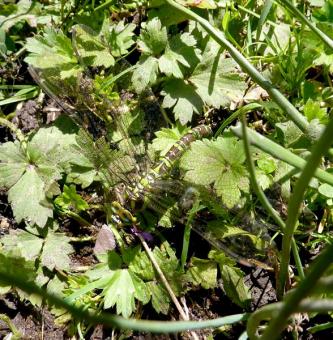It was a treat for me to be out with the group today, and to be in the company of so many members was a pleasure. There were twenty two of us at Denso Marston for the first stop of this tour of Baildon sites.
The Denso Marston Reserve was created 25 years ago as a condition of the company building on the river corridor. They now employ a warden 3 days a week to manage the reserve and co-ordinate the education visits. Today we were led around by volunteer Harry Whiteley. His knowledge of the reserve and of insects in particular greatly enhanced our visit. Harry told us of two species of hoverfly whose larvae eat rotting wood. They have recently been identified at Denso - the first recordings in this area.
 Southern HawkerThe weather was very kind with some end of summer sunshine encouraging the dragonflies around the pond. We saw a Southern Hawker laying eggs on the plants at the margin of the pond while the male patrolled nearby, and several Brown Hawker feeding over the water.
Southern HawkerThe weather was very kind with some end of summer sunshine encouraging the dragonflies around the pond. We saw a Southern Hawker laying eggs on the plants at the margin of the pond while the male patrolled nearby, and several Brown Hawker feeding over the water.
The Purple Loosestrife was in full flower, and in total 107 species of flower were recorded either in flower or fruit, including Musk Mallow, Lesser Bullrush and Fringed Water Lily.
After lunch and group photos, we relocated to nearby Tong Park. The plants here included Greater Birds-foot Trefoil, Burr Reed and Water Pepper. John informed us the grassy bank with a good amount of Devil's Bit Scabious was one of the best places in Baildon for Small Copper butterflies and Wall Browns, however none had been seen this year. Several people were lucky to see the flash of a kingfisher across the large pond by the cricket ground, were there was also several Little Grebe, Moorhens and Swans.
The final stop of the day, via the ice cream van, was to the area of Baildon Moor where BEES Conservation Volunteers have undertaken bracken control for the last decade. I explained the principles of the work undertaken and we had a quick look at the moorland plants that are benefiting from management; Heather, Cross-Leaved Heath, Bilberry (still in flower) and Crowberry. With the Meadow Pipits singing we returned to the minibus and back to town.
See the rest of the photos in the gallery . Thanks for having me, Julia.
